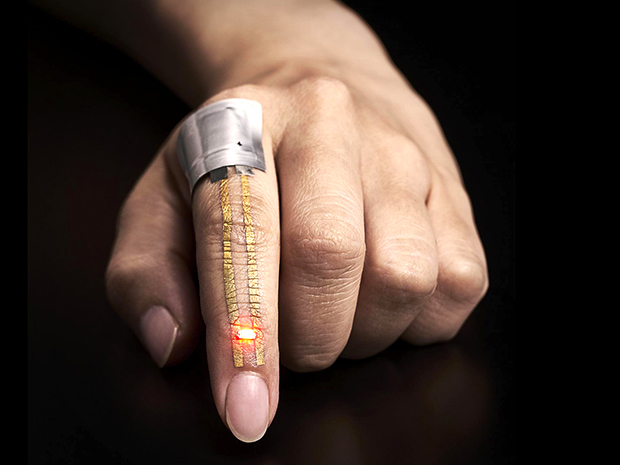
Sensors represent the “eyes,” “ears,” or “noses” of data processing systems in numerous applications in our day-to-day lives. Sensors typically provide real-time information about the environment accurately and efficiently and simplify modern technical systems, making them more cost-effective, reliable, and safer.
Today, there is an increasing demand for miniaturized, cost-effective, and reliable sensors capable of monitoring multiple environmental, chemical, physical, and biological parameters, such as temperature, strain, pressure, magnetic field, light intensity, etc.
Sensors are broadly classified into two categories, flexible and non-flexible. Flexible sensors are fabricated of materials that are malleable to a certain extent without changing their properties, whereas non-flexible sensors are rigid and made of brittle materials.
The non-flexible sensors are the most common ones today being used in a vast field of applications, but they have certain disadvantages like stiffness, intransigency, etc. These disadvantages are extremely prominent, especially when the sensors are associated with monitoring physiological parameters of a person or any application which involves stress and other extreme conditions which can damage the sensor.
Therefore, flexible sensors are considered the best alternative because of their better mechanical and thermal properties, low fabrication cost, and lightweight. These flexible sensors are widely used in various kinds of wearables today, which can perform real-time monitoring of several physiological parameters and movements, such as walking, running, muscle movements, body temperature, etc. They are much more compact, easier to use, and have a much faster response time.
Compared to non-flexible sensors, flexible sensors have prominent advantages, making them a significantly better choice for most wearable sensing systems. Some of the advantages of flexible sensors are:
- They are thinner and have high flexibility and bendability, which reduces intransigency effects apparent in their rigid counterparts.
- Higher impact resistance
- Higher sensitivity, linearity, hysteresis, response time, and durability
- Flexible, thin, conformal, transparent, and stretchable
- They are lower in cost, lighter, more robust. Faster production and turn around
- Organic/biocompatibility and biodegradability
- Self-powered and better wireless communication
A flexible sensor consists of three basic components: a substrate, active element, and electrode/interconnect. A substrate is the main source for flexibility and stretchability of wearable sensors and directly determines the comfort level and long-term reliability. The common materials used to develop flexible sensors are organic, inorganic, and hybrid polymers such as polyethylene naphthalate (PEN), silicon, and polydimethylsiloxane (PDMS), which have high elasticity, and low dielectric constant, making them lower in cost compared to other flexible substrates.
Among the various fabrication techniques available to produce flexible sensors, some of the most common ones are:
- Photolithography, using light (UV) to pattern a design.
- Screen printing in which a mesh is used to transfer inks from one side to the other side.
- Laser printing that uses the laser to scan or curve out parts of the substrate to form a design.
- Ink-jet printing that replaces the ink with conductive ink.
- Casting that uses a template forming a mold.
- Weaving that uses handlooms or any weaving device to develop fabric embedded flexible sensors
Some of the common types of sensing performed with the wearable, flexible sensors are as follows.
Electrochemical sensing is one of the most common types of flexible sensing that has been performed over the years. With their unique chemical and electronic properties, the flexible sensors have been an excellent choice to carry out different types of biochemical sensing. Some common types of electrochemical sensing include monitoring glucose, cholesterol, etc.
Pressure and strain sensors are the most standardized applications of flexible sensors. Various kinds of piezoresistive and piezoelectric sensors have been developed to date to monitor various physiological parameters using bandages, gloves, etc.
Biomedical signal monitoring is another sector that has been worked up with wearable, flexible electronic devices. Monitoring of metabolites on the skin is done by sensors with ion-electron potentiometric transducers. Oppositely charged multilayered films are used to establish chemoresistive sensors, while the detection of sodium (Na+) and potassium (K+) ions are detected using a sensor designed with Cu/PI flexible electronic layer. Monitoring of saliva is done using graphene nanosensors.
Flexible Organic electrochemical transistors (OECTs) are another type of sensor used for testing saliva by converting biochemical signals to electrical signals. They are developed with a PANI/Nafion – graphene bilayer film. These sensors are also used as pressure sensors and in large-area sensor skins.
Magnetic field sensors are developed using inorganic functional nano-membranes with polymeric foils.
Though different techniques and materials are used to construct wearable, flexible sensors, the mass production of these sensors is still challenging due to the existing weakness in cost, fabrication efficiency, and high-performance consistency. Continuous investment in material preparation and fabrication process perfection plays a significant role in constructing cost-effective, consistent wearable flexible sensors.




















![A complete history of wearable technology: A timeline [Updated]](https://roboticsbiz.com/wp-content/uploads/2019/11/Sony-Walkman-218x150.jpg)

